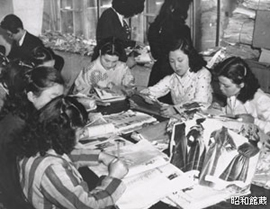Learn About Japan > Work and Workplaces in Japan > Women > Popularity of American Style Fashion and Western Dressmaking

|

Women
- Introduction of Female Suffrage
- Tokuju (Special Order) Boom and Female Workers
- Increase of Female Employees
- Popularity of American Style Fashion and Western Dressmaking
- Part-time Female Workers
- Women and Agriculture
- Ama (Female Diver)
- Marriage Retirement and Retirement Ages for Men and Women
- Office Ladies (OL)
- Dual Tracks in Female Occupations: Ippan Shoku (Non-Career Track) and Sōgō Shoku (Career Track)
- Laws Regarding Working Women
- Sexual Harassment
- Low Birth Rate and Working Women
- Separate Surnames for Married Couples
- Female dominant occupations
- “Mighty” Women: Police and the Military Self Defense Force
|

Women gathering at a library and taking notes from dressmaking magazines. 1949.
Photo Courtesy of National Showa Memorial Museum.
Popularity of American Style Fashion and Western Dressmaking
Under the American Occupation, American culture was introduced to Japan and American style fashions became common among Japanese women. With the popularity of Western clothing, dressmaking became a skill that many women could use to earn income. Many women learned dressmaking from magazines and at dressmaking schools. Then they earned income by working at boutiques, making dresses to order, or by teaching dressmaking. With the dressmaking boom, the number of sewing machines produced in Japan increased rapidly and exceeded one million a year in 1951.Dressmaking magazines at the time were so sophisticated that they taught readers not only how to sew but also how to draft patterns. Therefore, many women learned complicated skills from magazines. While dressmaking schools were a place for women to acquire professional skills to get jobs, they also served as “bride schools” where women learned homemaking skills before marriage.
|
|
|
| Download Podcast in
English
| Japanese
|
|
Document |
Audio-Video |
Chart |
Picture |
Map
|
|

